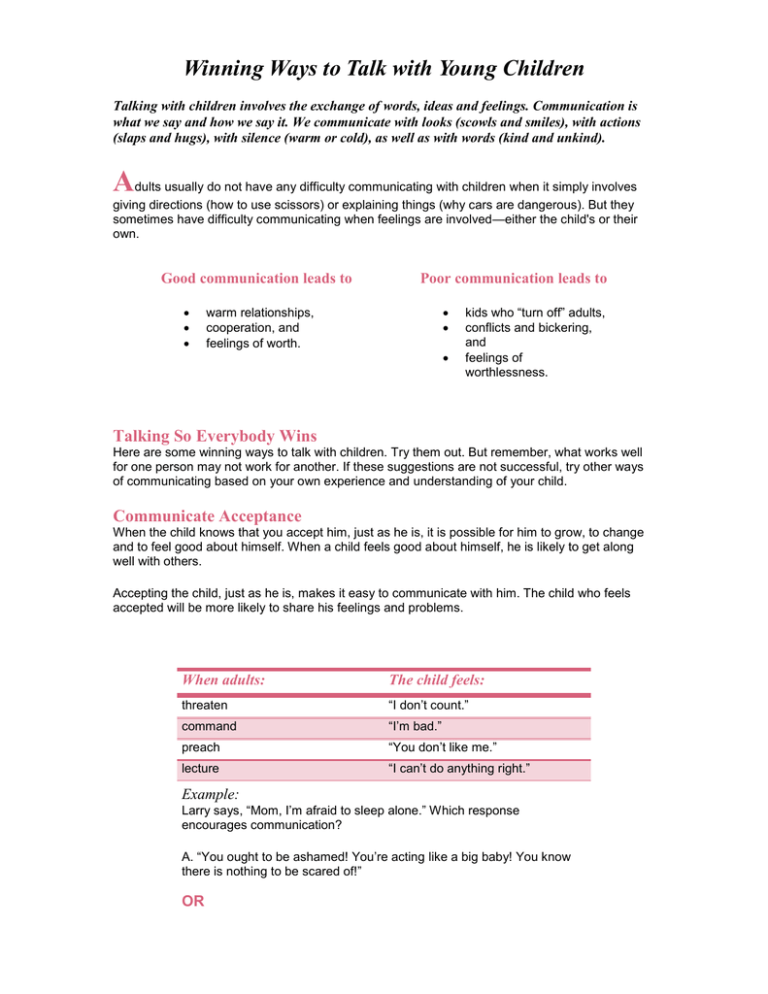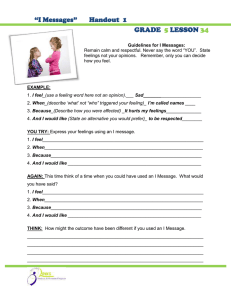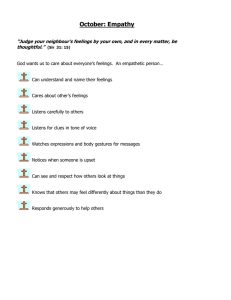Winning Ways to Talk with Young Children
advertisement

Winning Ways to Talk with Young Children Talking with children involves the exchange of words, ideas and feelings. Communication is what we say and how we say it. We communicate with looks (scowls and smiles), with actions (slaps and hugs), with silence (warm or cold), as well as with words (kind and unkind). Adults usually do not have any difficulty communicating with children when it simply involves giving directions (how to use scissors) or explaining things (why cars are dangerous). But they sometimes have difficulty communicating when feelings are involved—either the child's or their own. Good communication leads to Poor communication leads to warm relationships, cooperation, and feelings of worth. kids who “turn off” adults, conflicts and bickering, and feelings of worthlessness. Talking So Everybody Wins Here are some winning ways to talk with children. Try them out. But remember, what works well for one person may not work for another. If these suggestions are not successful, try other ways of communicating based on your own experience and understanding of your child. Communicate Acceptance When the child knows that you accept him, just as he is, it is possible for him to grow, to change and to feel good about himself. When a child feels good about himself, he is likely to get along well with others. Accepting the child, just as he is, makes it easy to communicate with him. The child who feels accepted will be more likely to share his feelings and problems. When adults: The child feels: threaten “I don’t count.” command “I’m bad.” preach “You don’t like me.” lecture “I can’t do anything right.” Example: Larry says, “Mom, I’m afraid to sleep alone.” Which response encourages communication? A. “You ought to be ashamed! You’re acting like a big baby! You know there is nothing to be scared of!” OR B. “I know you’re scared. I will turn on the night light, and leave the door open for you.” Remember: We can accept a child without necessarily approving of his behavior. For example, we love and accept Sandra, but we do not accept her behavior when she hits the baby or pulls the cat’s tail. Use Door Openers Door openers are invitations to say more, to share ideas and feelings. They tell the child that you are really listening and interested, that her ideas are important, and that you accept her and respect what she is saying. Examples of Door Opener Statements: “I see.” “Oh.” “Mm hmmm.” “How about that!” “Really?” “Tell me more.” “Say that again. I want to be sure I understand you.” “No kidding.” “That’s interesting.” Door openers tell the child that her ideas are important, that you are interested in her ideas, and that you respect her ideas. Listen Attentively Get rid of distractions and pay attention to what the child is saying. At times, adults may need to stop whatever they are doing and listen to the child. It is difficult to run the vacuum cleaner, cook dinner or read the paper and, at the same time, pay close attention to what the child is saying. Caution: Do not pretend that you are listening when you aren’t. If you are busy—talking on the phone or entertaining guest—give your child a specific time when you can listen. Then be sure to follow through. Use More Dos Than Don’ts Tell the child what to do rather than what not to do. Using “dos” rather than “don’ts” is very difficult, especially if adults already have the “don’t” habit. It is very difficult to break bad habits. Using “dos” rather than “don’ts” requires much thought and practice. However, the improvement in your relationship with your child will make it worth the effort. Talk to children as you talk to your friends. If adults would talk to children with as much consideration as they talk to their friends, they could really communicate with children and be on the way to excellent relationships. Examples of Don’ts: Examples of Dos: Don’t drag your coat on the ground. Hold your coat so it doesn't drag. Don’t squeeze the kitten. Carry the kitten gently. Don’t slam the door. Close the door softly, please. Don’t draw on the table. You can color on this page. Talk with, Not at, Children Talking “at” the child is one-sided conversation: “Put on your raincoat;” “You are going to spill that;” “You need a haircut.” Adults who talk “at” children often use the excuse that a small child cannot converse at the adult level. But no one—including the young child—likes to be talked “at.” You may talk “at” the family dog, or even a tiny baby, but try to talk “with” a young child. Talking “with” a child is two-way conversation—talking to him and then listening to what he has to say. Forming the habit of talking “with” children rather than “at” them will be especially helpful when they become teenagers. Use “I Messages” to Communicate Your Thoughts and Feelings “I messages” are statements of fact. They tell the child how his behavior makes the adult feel. Often, children don’t know how their behavior affects others. “I messages” are much more effective than “you messages” when the child misbehaves. “I messages” give the child responsibility for changing his own behavior. For example, if the adult says, “I see a dirt smudge on your face,” he is giving the child the responsibility to do something about the dirt smudge. Caution: Instead of using “I messages” to express anger, express the emotion that came before the anger. For example, let’s say Bruce runs into the street chasing his ball. Fear probably comes before anger. Say, “I am really afraid you will be hurt when you run into the street.” Don’t say, “I’m really mad at you.” Examples of “I-messages”: Examples of “You-messages”: I need help picking up now. You made a mess. I don’t feel like reading a story when I’m tired. You’re a pest. I sure get upset when I see mud on You ought to be ashamed at this the floor. mess. I can’t hear you with all that screaming. You better shut-up! I don’t understand. You’re dumb. Make Requests Simple Young children have a hard time remembering several orders at a time. Remember when you asked for directions in a strange city? You were probably confused when told to “Go six blocks, turn left and go past the gray slate building, turn right at the third blinker, go south and circle the courthouse.” Three-year-old Sarah will be just as confused when you say, “Go to your room, and hang up your clothes, but first pick up your toys, and put the dog out.” Probably Sarah and the dog will both disappear outdoors because “put the dog out” is all Sarah remembers. Get the Child’s Attention Before Speaking Young children can concentrate on only one thing at a time. Call the child’s name and allow him or her to pay attention to you before you speak to him or her. Examples: “Jack.” (Wait until he stops throwing the ball and looks at you.) “Dinner will be ready in 15 minutes.” “Jill.” (Wait until she stops playing in the sand and looks at you.) “It will be time to come inside in 10 minutes.” Make Requests Important Speak as if you mean it, and give the child a reason why he must do this thing at this particular time. A request made in a wishy-washy manner lets children think you do not really care whether or not they do what you asked. A child can think about only one thing at a time. When involved in play, it is hard to shift attention to you. Also, they don’t like being interrupted during play any more than you do when you are reading the newspaper. Communicate at Eye Level Eye contact improves communication. When talking with very young children, it may be necessary to stoop down to their level or to sit at a table with them. Say “Please,” “Thank You” and “You’re Welcome” to Children Children deserve the common courtesies that adults use with each other. Children also learn by imitating the speech and behavior of adults. Let them learn to say “please” and “thank you” by imitating you. Nagging a child to say “please” sets a bad example; it is not courteous. Try Not to Interrupt and Scold Children When They’re Telling You Their Stories Jeanie came in quite excited and started to tell Mother about the good time she had playing at Betty’s house. Mother interrupted Jeanie—rudely and at great length—to scold her for going to Betty’s house without permission. Jeanie immediately lost interest in sharing her feelings with Mother. Mother certainly should remind Jeanie of the rule about asking permission, but at another time. Don't Use Unkind Words, Which Tear the Child Down Unkind words have unhappy results, and they cut off communication. Avoid unkind words that are: • Ridiculing—”You’re acting like a baby.” • Shaming—”I’m ashamed of you.” • Name-calling—”You’re a bad boy.” Unkind words, spoken without thinking of their results, make the child feel disliked. They discourage the child and give him or her a poor self-concept. More important, unkind words do not help. They only make matters worse. Use Kind Words to Encourage and Build Up the Child Kind words bring happy results! They give the child more self-confidence and help her behave better, try harder and achieve more. They communicate love and respect. They create an atmosphere in which problems can be discussed openly and understandings can be reached. Suppose the child has spilled her milk on the floor. You can say, “Don’t be so clumsy! Just look at the mess you made.” This leads to unhappy results. Or you can say, “Here is a sponge. Please wipe the milk up,” with happy results. Examples of kind words: “Thank you for helping me clean off the table.” “You did a good job of washing the dishes.” “That really makes me feel good.” “I love you.” “I like the way you remembered to hang up your coat.” The Importance of Good Communication Good communication helps children develop confidence, feelings of self-worth and good relationships with others. It makes life with them more pleasant and helps them grow into adults who have good feelings about themselves and others. References and Recommended Reading Parts of this publication were adapted from the following sources: Faber, A., & Mazlish, E. (1980). How to Talk So Kids Will Listen & Listen So Kids Will Talk. New York, NY: Avon. Child Guidance Techniques, Oregon Extension, by Roberta C. Frasier, Extension Family Life Specialist. Gordon, T. (1970). P.E.T.: Parent Effectiveness Training. New York, NY: Wyden. What Young People Want from Their Parents (1976). J. Van Horn, Family Life and Child Development Specialist, Pennsylvania State University. Genott, H. (1965/2003). Between Parent and Child (revised). New York: Times Rivers Press. Satir, V. (1988). The New Peoplemaking. Palo Alto, CA: Science and Behavior. Letters to Parents (1968). C. Martin, Extension Specialist, Human Relations, and Child Development, University of Arizona. Listening for Meaning Can Help Solve Problems (1975). Wisconsin Extension. University of Maine Cooperative Extension Bulletin #4077 For more information on family issues, contact your county Extension Office.


